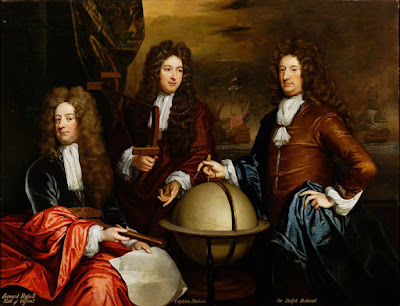 |
| Marco Bigio Three Stages of Womanhood ca. 1540-45 oil on canvas Pinacoteca Nazionale di Siena |
 |
| attributed to Girolamo Siciolante after a Michelangelo drawing Archers shooting at a Herm ca. 1540-45 oil on panel Galleria Borghese, Rome |
 |
| Pietro Paolini (il Lucchese) Concert ca. 1620-30 oil on canvas private collection |
 |
| Wenceslaus Hollar after Peeter van Avont Bacchic Scene with Putti and Infant Satyr ca. 1644-52 etching Metropolitan Museum of Art, New York |
 |
| David Teniers the Younger Gambling Scene at an Inn ca. 1645-50 oil on panel Wallace Collection, London |
 |
| Jacob Jordaens Charlemagne receiving the Homage of Caliph Haroun al-Raschid ca. 1665-75 tempera and gouache on paper (tapestry cartoon) Musée du Louvre |
 |
| Thomas Murray Portrait of Edward Russell, Earl of Orford with Captain John Benbow and Admiral Ralph Delavall ca. 1692-93 oil on canvas Government Art Collection, London |
 |
| Gaspard Duchange after Peter Paul Rubens La Paix confirmée dans le Ciel 1710 hand-colored etching and engraving Royal Academy of Arts, London |
 |
| Francesco del Pedro after Jacopo Tintoretto The Three Graces ca. 1791-94 etching and engraving British Museum |
 |
| Paul Gauguin Three Tahitians 1899 oil on canvas Scottish National Gallery, Edinburgh |
 |
| Constant Montald Fountain of Inspiration 1907 oil on canvas Musées Royaux des Beaux-Arts, Brussels |
 |
| Max Beckmann Conversation 1908 oil on canvas Alte Nationalgalerie, Berlin |
 |
| Gaetano Previati Way to Calvary 1912 oil on canvas Pinacoteca della Cassa di Risparmio, Tortona |
 |
| Arshile Gorky The Plough and the Song 1946-47 oil on canvas Art Institute of Chicago |
 |
| Anonymous Italian Photographer Pier Paolo Pasolini in Rome ca. 1950 photograph private collection |
"It was suggested earlier that the Old Masters had three ways of conceiving the picture plane. But one axiom was shared by all three interpretations, and it remained operative in the succeeding centuries, even through Cubism and Abstract Expressionism: the conception of the picture as representing a world, some sort of worldspace which reads on the picture plane in correspondence with the erect human posture. The top of the picture corresponds to where we hold our heads aloft; while its lower edge gravitates to where we place our feet. Even in Picasso's Cubist collages, where the Renaissance worldspace concept almost breaks down, there is still a harking back to implied acts of vision, to something that was once actually seen."
"A picture that harks back to the natural world evokes sense data which are experienced in the normal erect posture. Therefore the Renaissance picture plane as an upright surface survives the most drastic changes of style. Pictures of Rothko, Still, Newman, de Kooning, and Kline are still addressed to us head to foot – as are Matisse and Miró. They are revelations to which we relate visually as from the top of a columnar body; and this applies no less to Pollock's drip paintings and the poured Veils and Unfurls of Morris Louis. Pollock indeed poured and dripped his pigment upon canvases laid on the ground, but this was an expedient. After the first color skeins had gone down, he would tack the canvas on to a wall – to get acquainted with it, he used to state, as with a world confronting his human posture. It is in this sense, I think, that the Abstract Expressionists were still nature painters. Pollock's drip paintings cannot escape being read as thickets; Louis' Veils acknowledge the same gravitational force to which our being in nature is subject."
– Leo Steinberg, from Other Criteria (1972)
